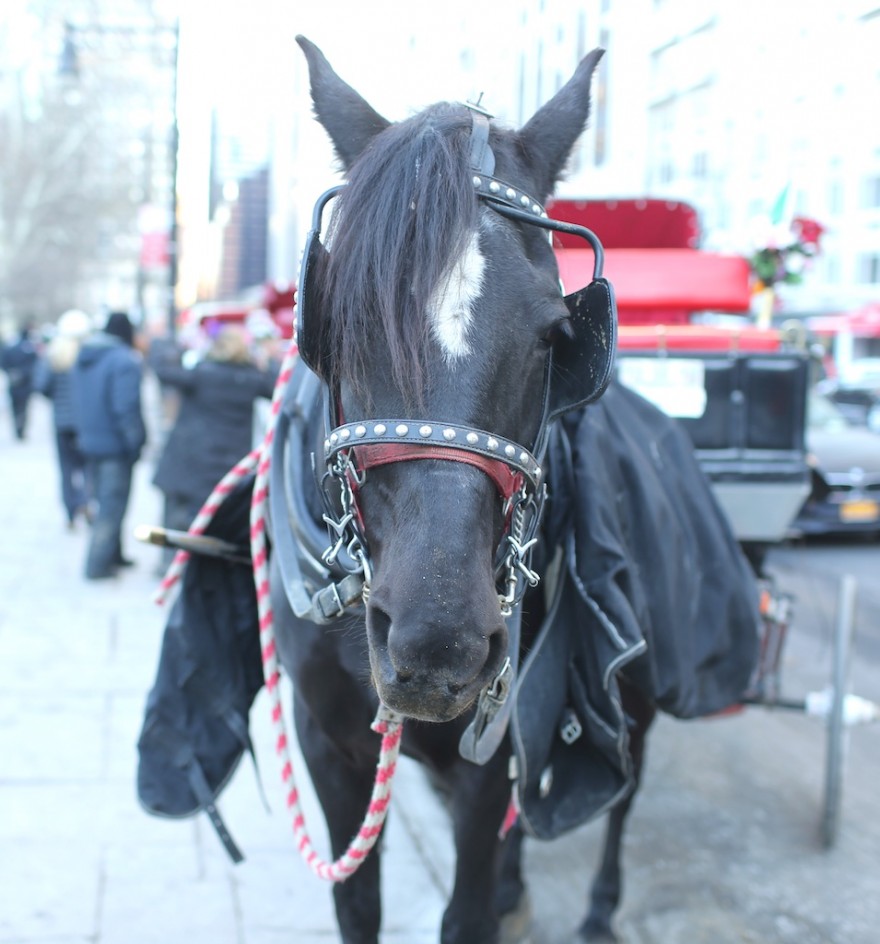
The mayor of New York City and his friends and colleagues in the animal rights movement say the New York Carriage Horses suffer from “unthinkable suffering” and that pulling carriages in Central Park is abuse. The horses, they say, are depressed and unhappy and yearn to return to the wild or to rescue farms where they will never be forced to work again. The carriage trade, says the mayor, is immoral and he seeks to ban the horses from New York and deprive the people in it of their work and way of life.
Over the past few months, I have written extensively about this controversy, and have talked with equine veterinary associations, equine vets, horse owners and lovers, trainers and behaviorists researching the story of the New York Carriage Horses. Along the way, I have been compiling a list of the most commonly agreed-upon ways to determine if a horse is content and healthy. I took this list to New York City this weekend and applied it to the carriage horses I saw waiting in the carriage line on the South side of Central Park.
I will, of course, share it with you – you are free to use it in any way – and I would encourage you to bring the list to New York City for yourself if you happen to be there and draw your own conclusions. The horses I saw seemed relaxed, content and healthy. I didn’t see a single one of these problems. I don’t use the term “happy” when writing about animals, I think it is a human word describing human emotions. I use the word “content,” which is what animals are when they are well cared for. Abused animals are almost never content or at ease.
I found the horses and drivers to be alert, curious and co-operative.
– The horse’s head. A content horse has an alert but relaxed expression. Look for for an open, bright, and friendly eye. A horse that is ill will show a pinched nostril, signs of respiratory distressed will be apparent by looking at the nostril or listening for signs of disturbed or congested breathing. The lips of a sick horse will be drawn, the horse’s face will appear tense, the eyes wide and showing white.
– A horse with his ears “pricked” forward is alert and aware of what is happening around him. If a horse’s ears are pinned back, nearly touching the neck, this may indicate anger or annoyance.
– An overworked or lame horse will have swollen legs, injured horses may be bleeding. An overworked or lame horse will not wish to put any weight on it’s feet (a calm horse will lift, or “cock” a rear leg, that is not a sign of injury). Horses with sound legs will stand upright and put pressure on all four legs when moving.
– Look for signs of lethargy. Horses that are discontented or suffering will often appear slow and sluggish, reluctant to move. They may hold their heads down or their ears back. They are reluctant to interact with other horses or people. They might bite or nip. They will often fail to notice people who approach them or who try and pet them or feed them or talk to them.
– Horses that are sick or unhappy may try and lie down, or move aimlessly, they may paw the ground. They will not eat oats or take carrots or other treats. They show no interest in what is around them.
– When a horse is angry or unhappy, he may also have his eyes wide open, nostrils flaring, he may be swishing his tail. A horse with a flared nostril has mostly likely been frightened or alarmed by something. Flared nostrils are usually seen along with wide-open eyes. (Or if a fly is bugging or biting the horse.)
– Look at the tail. A lifted tail when in motion indicates a horse in high spirits (or is about to take a dump.) Be prepared.
There is no need to follow the Pong-like arguments of the animal rights people and the people in the carriage trade The horse people are transparent, you can go see the horses for yourself in the stable or at Central Park any time you like. I know most of the people reading this are not near New York City, which is why I am writing this, but a lot of people are. Many of them will help determine the fate of these beautiful and very safe animals. Thousands have gone to see the horses for themselves.
I know of no one who has gotten close to these horses who has found them to be depressed or depressing, suffering or unhealthy. Animals deserve at the very least to be known and understood by the people presuming to decide their fate. All of the information I have gathered is available on my blog archives or elsewhere online or in cited research. You can, of course, gather it for yourself.
